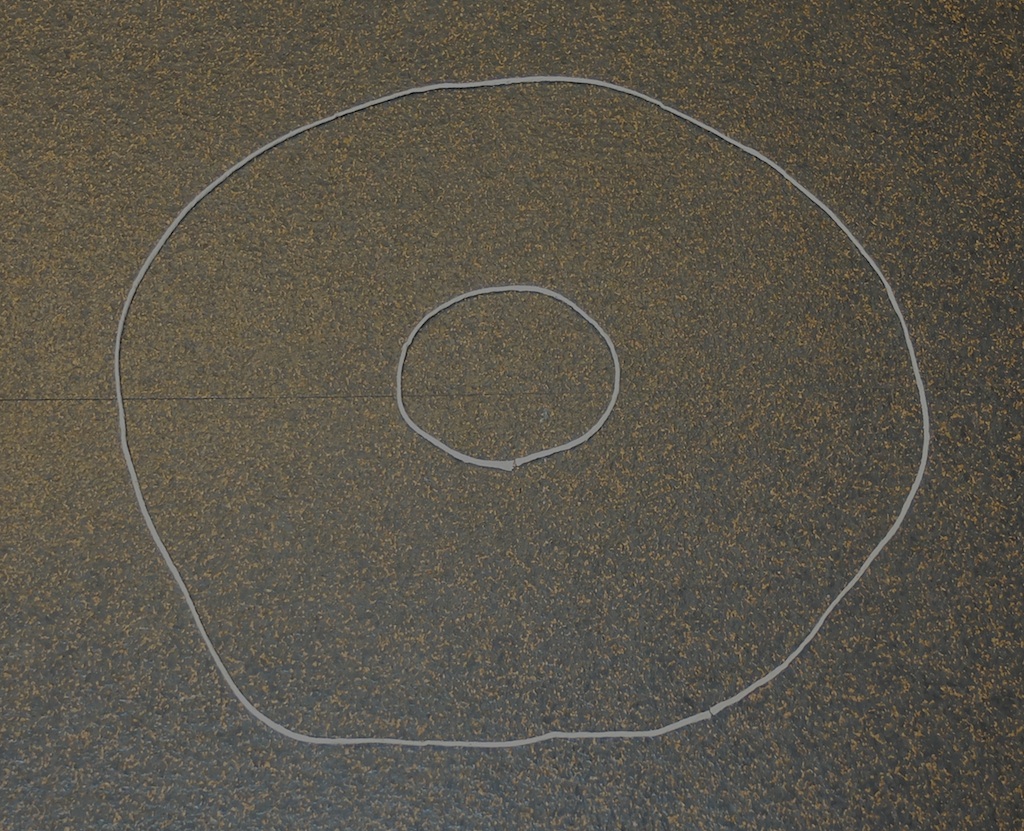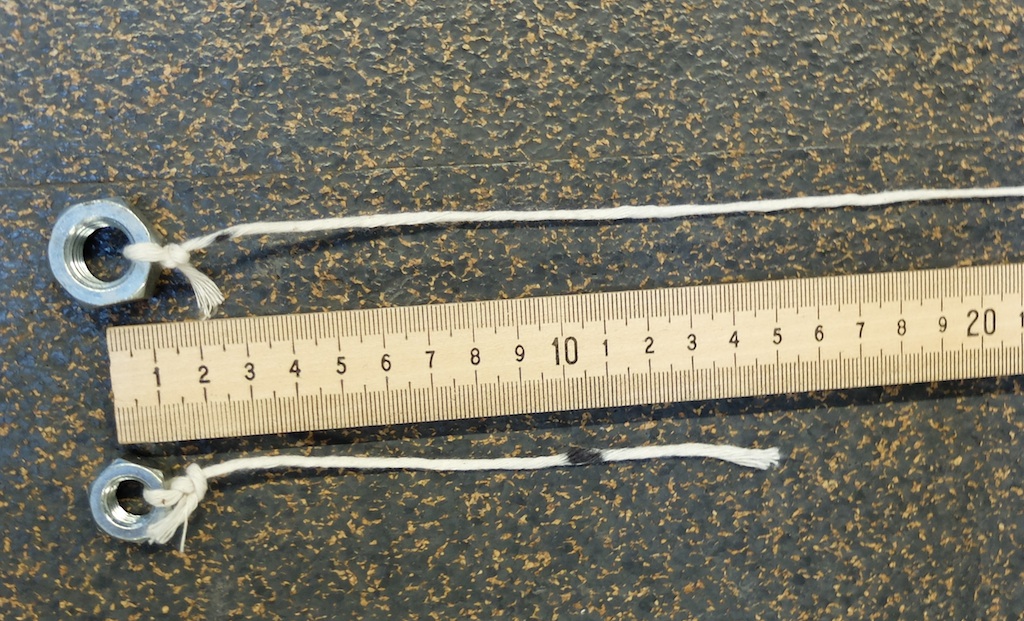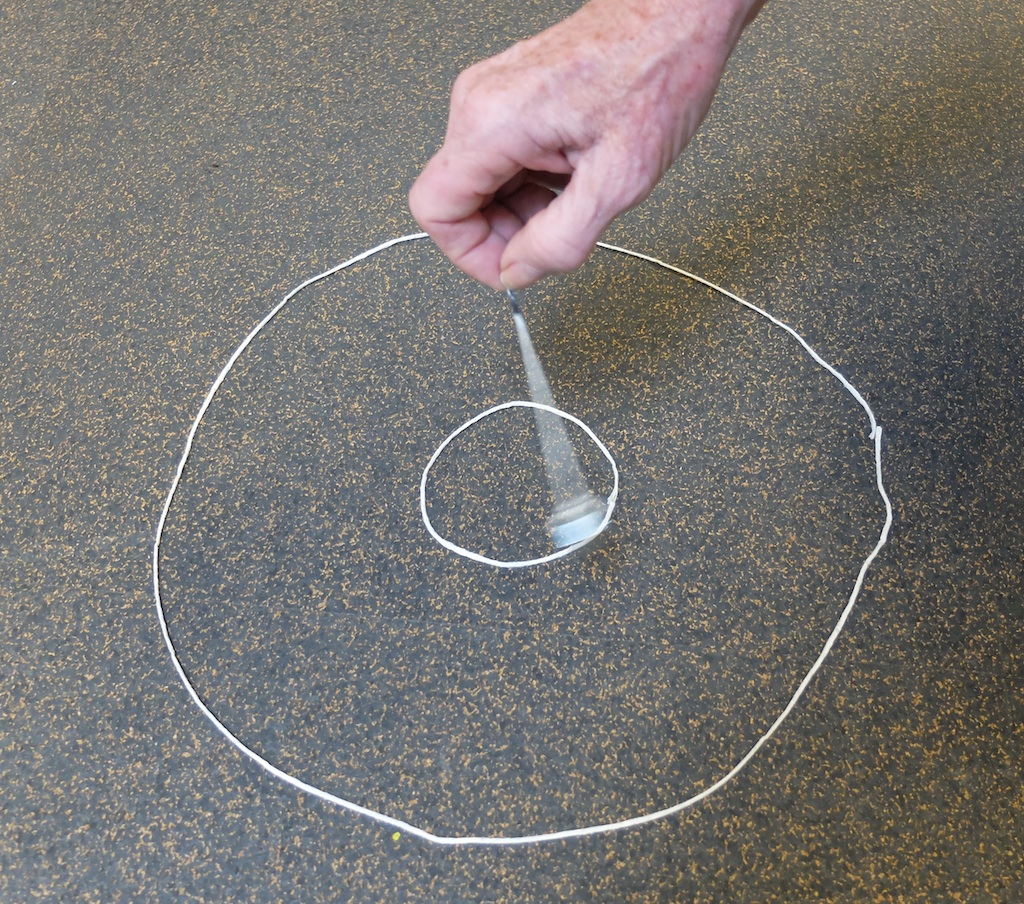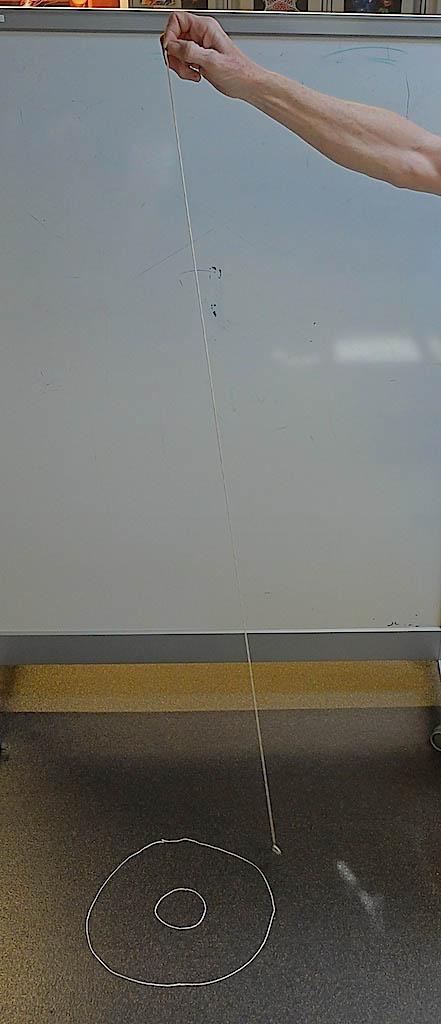
Who's the fastest one of all?
Introduction
Let's model the orbits of the innermost planets using string. Then use some more string to make a conical pendulum to model the periods of their orbits.
Knowing the circumference of the orbit and the period we can compute the speed of the planet.
Material
String, perhaps 10 m
weight, such as a large nut
Ruler, a meter stick
Stopwatch
Marker pen, a Sharpie
Scissors
To Do and Notice
| L orbit string cm | Orbit Radius cm | Orbit Radius AU | Orbit length AU | |
|---|---|---|---|---|
| Me | 30 | 5 | 0.4 | 2.4 |
| Ve | 50 | 8 | 0.7 | 4 |
| Er | 75 | 12.5 | 1.0 | 6 |
| Ma | 120 | 20 | 1.6 | 10 |
Cut strings for planets Me, Er, and Ma in the table.
Notice that the inhabitants of Er put themselves in a privileged position and decide to make the radius of their orbit the standard unit of measure called the Astronomical Unit, or AU.

Notice how much longer the path for Ma is than that for Me, it is four times longer.
Form the strings into concentric circles with the same centers. In the image we have shown the strings for planets Me and Ma insert Er yourself.
Give the students this table and have them fill in the blanks. (Note that student measurements will have some errors but as long as they are reasonably colose it will not matter)
| L orbit string cm | Orbit Radius cm | Orbit Radius AU | Orbit length AU | |
|---|---|---|---|---|
| Me | 30 | |||
| Ve | 50 | |||
| Er | 75 | 12.5 | 1.0 | 6 |
| Ma | 120 | 20 |

Now let's make the planets go around.
| Length of pendulum cm | |
|---|---|
| Me | 10 |
| Ve | 54 |
| Er | 160 |
| Ma | 640 |
Make two pendulums one for Me and one for Er with lengths given by the table above.
Cut the strings about 20 cm longer than the pendulum length to give yourself room to tie the nuts onto the bottom of the strings. When you have done that measure the pendulum length from the middle of the nut to the correct length and make a mark with the marker pen.

The planet Me pendulum is 10 cm long and the planet Er pendulum is 160 cm long.
Pinch the planet Me pendulum just above the black mark and make it swing around in a circle just above the planet orbit circle on the floor.
Note that the period of the pendulum depends on the length of the string but it does not depend much on the radius of the circle it swings around as long as the string does not spin around with too larger an angle from the vertical. Just as the period of a pendulum swinging in one plane does not depend on the angle of the swing as long as the angle is reasonable small.

Measure the period, T, of one orbit.
This will be too hard to do for 1 orbit so we usually time 10 orbits and divide the total time by 10.
To do this count ZERO as you start the stop watch, then ONE after one orbit, and finally TEN after the tenth orbit.
(Be careful you don't fall into the common trap of counting ONE when you start the stopwatch.)
Now do the same thing for planet Er.

Which one appears to be going faster? Are you sure? Notice how long the path that the planet Er is going.
Let's use math to calculate the answer.
Remember that speed is distance divided by time. The distance is the length of the orbital path, the time is the orbital period.
For Me that is L/T = 30cm/0.6s = 50 cm/s
For Er that is L/T = 75cm/2.4s = 31 cm/s
And we see that indeed Me is faster. It's period is much faster, because not only is it moving faster it travels a shorter distance to go around one orbit.
The inhabitants of Er also think that everything should be based on the time it takes them to go around the sun once, they call this the year, yr, in this model 1 yr is 2.4 seconds. They measure the orbital periods of other planets in terms of their years.
Comparing Er and Me we see that the period of one orbit of Me in our model is 0.6 s which is one quarter of an Er year.
| Radius of orbit AU | Period of orbit s | Period of orbit yr | Speed cm/s | Speed AU/yr | |
|---|---|---|---|---|---|
| Me | 0.4 | 0.6 | 0.25 | 50 | 10 |
| Ve | 0.7 | ||||
| Er | 1.0 | 2.4 | 1.0 | 31 | 6 |
| Ma | 1.6 | 4.8 | 2 |
Notice that to do planet Ma you will need a high space from which to hold the string.
What's Going On?
With as many planets as we have there is obviously some sort of law connecting the perios and the orbital radii.
The law was found by Johannes Kepler who measured the orbital radii, and the orbital periods of the planets.
He discovered that the orbits were close to being circles, although Mars was an slight ellipse.
The relationship between the radius of an orbit, r, and its circumference, C, is of course C = 2pir. So the circumference of the earth's orbit is 2pi AU or 6.28 AU.
In our tables we measured them to two significant figures at most.
He discovered that the planet with the smallest radius traveled the fastest and so had a much shorter period.
Math Root (optional)
(Note this goes into 12th grade high school math)
Kepler discovered a law that connected the period of an orbit to its radius. He found that the square of the period of the orbit was proportional to the cube of the radius.
T^2 = c r^3
Where c is a constant of proportionality.
This is Kepler's third law.
This means that since Mars had 4 times the orbital radius radius of Mercury its orbital period was the square root of 4 cubed equals 8 times longer than the orbital period of Mercury.
We wanted to make a model of planet orbits using simple tools. So we modeled the orbits using pendulums, with the weight moving in a circle,these are known as conical pendulums.
The period, T, of one orbit of a conical pendulum of length, L,is the same as the period of a pendulum swinging back and forth in a plane.
T = 2pi(L/g)^0.5
Where g is the acceleration of gravity, about 10 m/s^2
To find the lengths of the conical pendulums combine this equation with Kepler's third law.
T^2 = 4pi^2 L/g = c r^3
The length of the pendulum is proportional to the cube of the orbital radius.
The orbit of Mars has 4 times the radius of the orbit of Mercury so its pendulum length must be 4^3 or 64 times longer than Mercury's.
Scientific Explorations by Paul Doherty |
20 May 2015 |